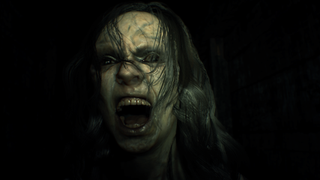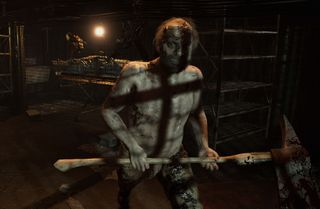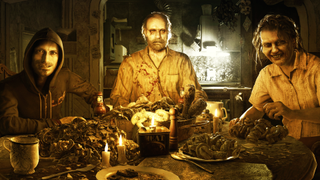
*Spoiler warning: The first few paragraphs of this article are about a story incident which occurs at the start of the game.
Early on in Resident Evil 7 your wife chops off your hand with a chainsaw, leaving you staring incredulous at a stump geysering blood. As you mouse click to pick your sad hand up, you’re left in no doubt that from here all bets are off. It’s a key moment for the horror reboot, because it subverts the expectations of players who had grown overfamiliar with the series. And according to game director Koshi Nakanishi, the scene was nearly even nastier.
As part of his talk entitled ‘Taking Resident Evil Forward by Looking Back’, which took place at the Game Developers Conference in San Francisco yesterday, Nakanishi said that the hand-slicing sequence came about early in development, and was the suggestion of their art director who felt the beginning of the game “lacked punch”. His original idea was to have the hero’s entire lower torso sliced off, after which the player would be forced to crawl, entrails trailing, to a safe room.
In the end, bisecting the hero entirely was deemed a little extreme, but Nakanishi said the team wanted to put Ethan into situations that even they weren’t sure how to escape from. At the start of the presentation, Nakanishi told the audience that the Japanese working title for Resi 7 was ‘Harawata’, which translates to ‘guts’. That makes more sense once you hear the torso anecdote, but Harawata also forms part of the Japanese name for the Evil Dead movies—which was another key inspiration.
Nakanishi said they wanted to capture the same claustrophobic vibe as the first film, which meant confining the action to an abandoned house and limiting the number of antagonists to four or five characters. These of course eventually became the deranged Baker family.

To celebrate Resident Evil 7 going gold, a parody video was created documenting the development process. Nakanishi showed us it, and a couple of the more interesting bugs listed were "Jack’s model is transparent" and "Jack's model is only wearing underwear". I guess Jack just gotta Jack.
He told us that there’s a danger in horror games that players get too comfortable with defeating the same enemies, and the resulting sense of catharsis stops them feeling scared. So, to keep players on their toes, the team themed each Baker around a horror subgenre. Marguerite, with her centipede puke and elongated limbs was given ‘body horror’, Jack became ‘slasher movie’ for obvious reasons, and Lucas got Saw-style ‘psychological horror’.
The aim for each of the Baker encounters was to create excitement through new mechanics, rather than just relying on shooting. However, this approach also meant ignoring some accepted game design wisdom. For instance, in the first battle against Jack, it isn’t necessarily obvious that you need to use the car to defeat him. Likewise, in the chainsaw duel with him, the normal design method would be to introduce the player to the chainsaw much earlier on. Instead, you’re thrown straight in and told to have at it.
The biggest gaming news, reviews and hardware deals
Keep up to date with the most important stories and the best deals, as picked by the PC Gamer team.
Taking such a bold approach came with plenty of risks. The new direction was first discussed at a meeting in Osaka in February 2014 to plot the future of the series after Resi 6. The edict from executive producer Jun Takeuchi was that Resi 7 had to be “scary but fun”, which is pretty broad as briefs go. The early goals the team settled on were that it should use a first-person camera, have a photorealistic look, be focused entirely on single-player with no co-op, and make minimal reference to the old characters or games.

Nakanishi said he was trying to recapture the same feeling players had when they picked up the first Resident Evil, and deliver imagery that was equally iconic. The similarities between the finished games are obvious. In both, you play as a new character, you’re trapped in a mansion infested with interesting enemies, and the only real goal is to survive. But Resident Evil 7 also dispenses with a lot of what the series has become best known for. There are no zombies, you can’t play with a friend, and there are few if any blockbuster-type action sequences.
Nakanishi made the point that in development what you choose to leave out is as important as what you put in. Had they tried to include every single element which the fans liked from the past games, they’d have been left with a confused mess he compared to the car Homer designs in The Simpsons. When time came to show the marketing team what the new Resident Evil looked like, they didn’t get too much pushback, but there were concerns over how the audience would respond. However, Capcom chairman Kenzo Tsujimoto—who Nakanishi refers to as ‘Big T’—gets the final say on these things, and backed the team.
Delays will not be tolerated
Production itself sounds like it wasn’t entirely easy sailing. The team opted for a very flat structure, which meant anyone could pitch ideas regardless of job title or discipline, (which is how they ended up with the art director coming up with the hand chopping). They also decided against maintaining long design documents at the start of project. Nakanishi conceded that some of the team struggled with the new structure, and at times it was chaotic and in danger of straying off course. Given that Takeuchi had given them free reign, but also warned that delays would not be tolerated, it was a stressful time.
At one point they considered opening with a 15-minute taxi ride during which you talked to the driver. Thankfully, that got chainsawed off too.
Nakanishi’s solution for those who were worried was to tell them to be more like Sam Raimi, and embrace the limitations they faced. After finding out that the Uncharted team had gone on a glamorous research trip to the desert, they decided to do something similar, visiting haunted houses and the backwaters of Louisiana looking for visual inspiration.
In the early stages of development, the team used Unity to block out crude versions of the most important beats. This enabled them to quickly decide what worked and what didn’t. For instance, at one point they considered opening with a 15-minute taxi ride during which you talked to the driver. Thankfully, that got chainsawed off too.
Nakanishi didn’t want to discuss sales, but Resident Evil 7 reportedly hasn’t been as successful as 6. Nonetheless, it’s already recouped its development cost, and the two games were released at very different times in terms of the console cycle. Resi 7 is also an undoubted critical hit, with reviews settling at 85 on Metacritic. “I can say with confidence, we have achieved our vision,” said Nakanishi.
Looking back over the series, he views the first three games as a trilogy united by the use of fixed camera angles, with Resi 4 to 6 forming a second trilogy of more action-orientated third-person games. He wouldn’t be clear on whether 7 will be the start of a new first-person trilogy, but also wouldn’t rule out taking a more action-heavy approach again in the future. At the end of the talk I asked him if there were any other sequences like the chainsaw dissection which they ruled out for being too gross. “Of course we did”, he said, “but I can’t give away all the secrets for our next game”.
With over two decades covering videogames, Tim has been there from the beginning. In his case, that meant playing Elite in 'co-op' on a BBC Micro (one player uses the movement keys, the other shoots) until his parents finally caved and bought an Amstrad CPC 6128. These days, when not steering the good ship PC Gamer, Tim spends his time complaining that all Priest mains in Hearthstone are degenerates and raiding in Destiny 2. He's almost certainly doing one of these right now.
Most Popular

